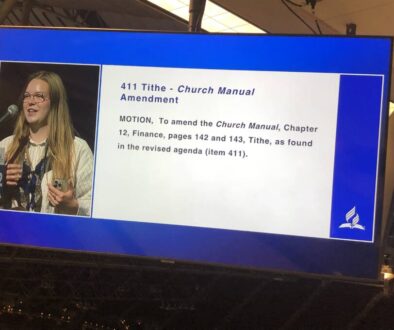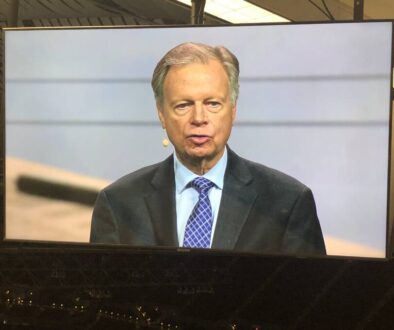Plan for Dissolution Put Forward by California Adventist Media Center Board
by Adventist Today News Team
On Monday the board of the Adventist Media Center in Simi Valley, California, a suburb of Los Angeles, discussed the results of an evaluation and planning process that has been underway for two years. The center is an institution of the North American Division (NAD) of the Seventh-day Adventist Church, and a news release from the NAD said only that the plan was “reviewed,” while the denomination’s official news service, Adventist News Network (ANN) announced on May 1 that the plan had been recommended by the board.
ANN did hedge by stating, “Still unclear is when the proposal will be brought to the NAD [executive] Committee or what the division’s future plans are.” The somewhat ambiguous language reveals the long-standing tension behind the scenes between the center as a denominational institution and the various media ministries, many of whom started as autonomous initiatives and continue to behave like independent ministries in the crucial relationships they maintain with donors.
Adventist Today asked NAD communication director George Johnson if the plan described in the NAD news release had been voted by the board and was told that he was not making any additional comments. One explanation, another source told Adventist Today, is that the recommendation of the media center board will be reviewed by the NAD officers and union presidents before it is cleared for the agenda of the full NAD executive committee. The officer group usually meets in August and the executive committee has its annual meeting in the fall.
The plan calls for the six ministries based at the center to relocate and for the facilities to be sold. Adventist Today has been told that it is expected that the ministries will move to different locations instead of establishing a new joint facility. Once a final decision is made on the plan, the six organizations will have 12 to 18 months to make their moves, the plan states.
The plan, as described in the NAD news release, includes three additional points: (1) “Utilize the studio facilities at the Division offices for production.” (2) An “ongoing commitment to providing funding for the media ministries” on the part of the NAD with “funding levels … identified for each of the media ministries,” which evidently means line-item budget allocations from the NAD’s share of Tithe. (3) A “commitment to explore new possibilities for media development [which] anticipates a significant role for the media ministries in the future.”
Many of these ministries have largely switched from broadcasting on local radio and television stations to cable channels, satellite systems and the Internet. The research and brainstorming that went into the planning process made a major point of the need for Adventist ministry to move into the booming social networking media on the Web.
Essentially the same plan as is now being announced was initially voted over a year ago, as Adventist Today reported at the time. Over the past year the six ministries have had time to develop their individual plans and decide if they wish to continue as part of a single center or each go their own way.
There has been discussion of the wisdom of bringing the ministries together in one institution since the media center was set up in 1972. At the time H. M. S. Richards, the founder of the Voice of Prophecy radio program, protested privately when his organization was forced to sell its facilities in Glendale, California, and move onto a campus with the others. At the time, Faith for Today needed to move from New York City because of the increasing cost of doing business there and It Is Written was housed at the General Conference offices in Maryland, but lacked any production facilities.
When the GC leadership pushed the media ministries into the new center, there were high hopes for the fruits of collaboration and experiments with new approaches. In fact, little of that potential has been realized over the last 30 years in the view of current and former staff who shared their opinions with Adventist Today. As early as 1987 media consultant Frank N. Magid conducted an assessment of the ministries and pointed out that as the founding figures left the scene, it would be difficult to continue to build audiences or raise sufficient funds.
In May 2011 the NAD convened a "media summit" in Ontario, California, and more than 100 communication professionals and staff from the media ministries listened to high-profile experts and discussed the implications of the fast-changing media context in America for Adventist media outreach. Since that time several additional studies have been done, including private interviews with stakeholders.
The Voice of Prophecy was founded as a radio program on a Los Angeles station in 1929. Richards was an evangelist in southern California and the GC committee had voted not to get involved with radio because some stations advertized alcoholic beverages and cigarettes. He told California congregations that he was not authorized to raise funds for a radio program, but that he had a "radio pocket" in his coat. Money was donated and the radio program began. At its height, it was heard on hundreds of stations across the U.S. and Canada. Richards retired in the late 1960s and his son, H.M.S. Richards, Jr., took over leadership of the program for three decades.
La Voz de la Ezperanza (The Voice of Hope) began during the 1940s with a program in the Spanish language parallel to the Voice of Prophecy. It is released on radio stations around the world and the organization also produces television and Internet materials.
Faith for Today began in 1950 when television caught the attention of American families and was originally a drama on the ABC network with an Adventist pastor as the key character. It is the oldest religious broadcast on television today, and also produces Lifestyle Magazine, McDougal MD, The Evidence, as well as an Internet ministry, Mad About Marriage seminars around the country, a mobile device channel and community concerts.
It Is Written was founded in 1956 by George Vandeman who was at the time an evangelist based in the GC ministerial department. Breath of Life began more recently and long featured African American evangelist Charles Brooks. Both of these television programs use a more traditional approach that focuses on preaching.
Jesus 101 Biblical Institute is the newest ministry, a Christ-centered teaching series featuring Bible scholar and Adventist pastor Elizabeth Talbot. It offers Bible study for seekers, church members, lay leaders and clergy.
A major function of all these media organizations has become the provision of programming for the several satellite channels that exclusively or largely carry Adventist content. They compete for donors and air-time with a number of other radio and television programs produced by Adventists in North America, some sponsored by local or union conferences in the denomination and some that are free-standing, private organizations.
The average member often thinks of these ministries as a single category and does not understand the organizational differences. This is especially true because all the media ministries, those sponsored by the denomination and those privately or locally organized, get the largest portion of their budgets from individual donors.
“The larger issues of how to best position the Adventist message in today’s media universe remain to be solved,” an expert who has taught media studies told Adventist Today. “Media is increasingly diverse, complicated and complex. There are now many thousands of ‘channels’ when you count Webcasting options and other new technologies. It is easy for a message to get lost in the noise and there is growing evidence the most people see and hear what they already believe and very few will tune in anything that is attempting to convince them of something they have not already bought into.”
Are media ministries an outdated concept? Adventist Today asked another media professional, and her response was, “Not if they are ministries. Ministry is what happens in a relationship with a person, not producing a recording or print materials or a Web page. Those media ministries that push their human assets onto the Web in a way that facilitates personal interaction, where their staff and volunteers are actually ministering to individuals will continue to have a viable role with a net of relationships. It is called ‘social networking,’ and by that I don’t mean just the well-known Web sites like Facebook. Ministry from the first century on has been mainly about social networking and if any media ministry that makes this paradigm the key architecture of their organization, will thrive.”



